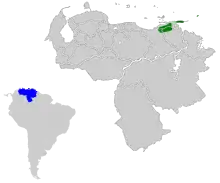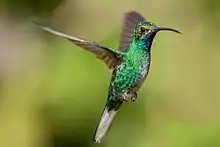White-tailed sabrewing
The white-tailed sabrewing (Campylopterus ensipennis) is a large hummingbird that breeds in northeastern Venezuela and Tobago. It was thought to have become extinct in Trinidad & Tobago after Hurricane Flora in 1963, but the population has now largely recovered. This species is now featured on Tobago's environmental posters under the nickname “Campy”.
| White-tailed sabrewing | |
|---|---|
.jpg.webp) | |
| Scientific classification | |
| Kingdom: | Animalia |
| Phylum: | Chordata |
| Class: | Aves |
| Order: | Apodiformes |
| Family: | Trochilidae |
| Genus: | Campylopterus |
| Species: | C. ensipennis |
| Binomial name | |
| Campylopterus ensipennis (Swainson, 1822) | |
 | |
Habitat
This bird inhabits mountain forests. The female white-tailed sabrewing lays its two white eggs in a relatively large cup nest on a low branch, often near water.

Description
The white-tailed sabrewing is 12 cm long and weighs 10 g. The sexes are similar, but the female is duller. The black bill is 25 mm long and slightly decurved. The adult male is bright green with a shiny blue throat and a white moustachial stripe.
The three outer pairs of feathers of the tail are white and the shafts of the outer flight feathers are thickened and flattened which gives the distinctive feature of the sabrewings, their English and genus names. In this case, both parts of the scientific name refer to this feature, Campylopterus and ensipennis being derived from the Greek and Latin respectively for "bent wing".
Diet
The food of this species is nectar, taken mainly from undergrowth flowers. Male white-tailed sabrewing perch conspicuously and defend their territories aggressively against other hummingbirds. This large species is fearless and inquisitive. The call is a rolled chinzink.
References
- BirdLife International (2012). "Campylopterus ensipennis". IUCN Red List of Threatened Species. 2012. Retrieved 26 November 2013.CS1 maint: ref=harv (link)
Notes
External links
- White-tailed sabrewing videos on the Internet Bird Collection
- White-tailed sabrewing photo gallery VIREO
- Photo; Article www.tsgcs.co.uk
